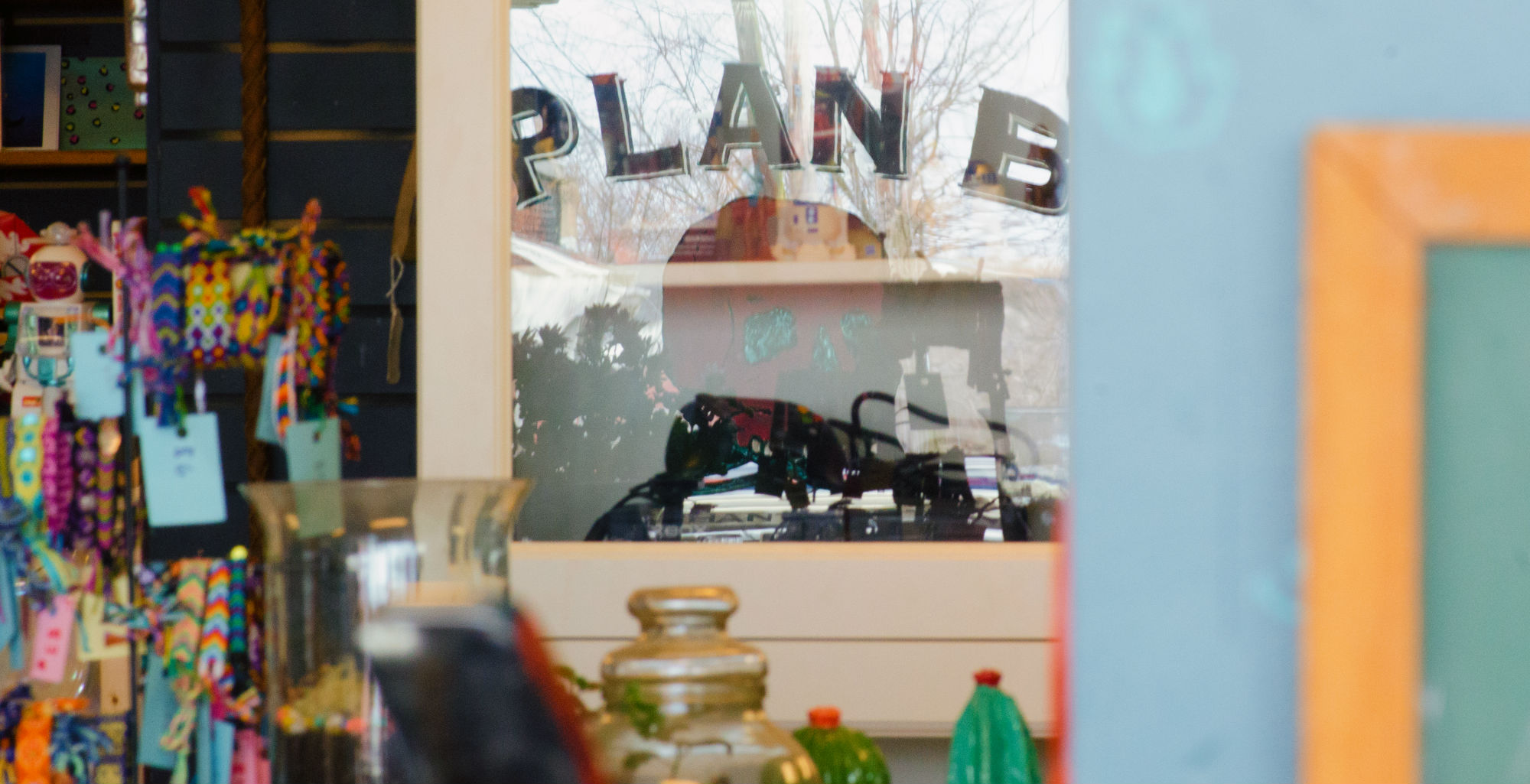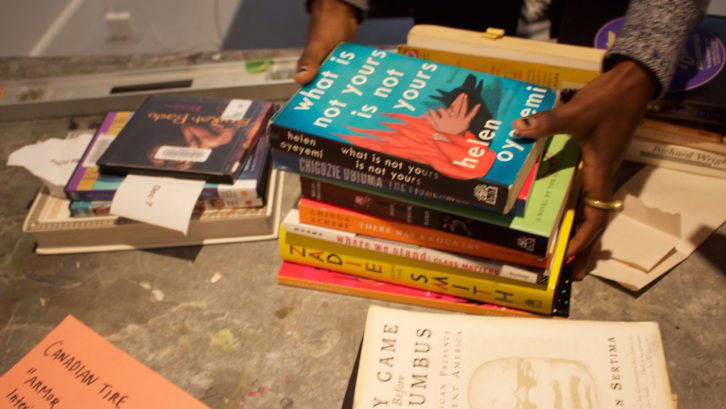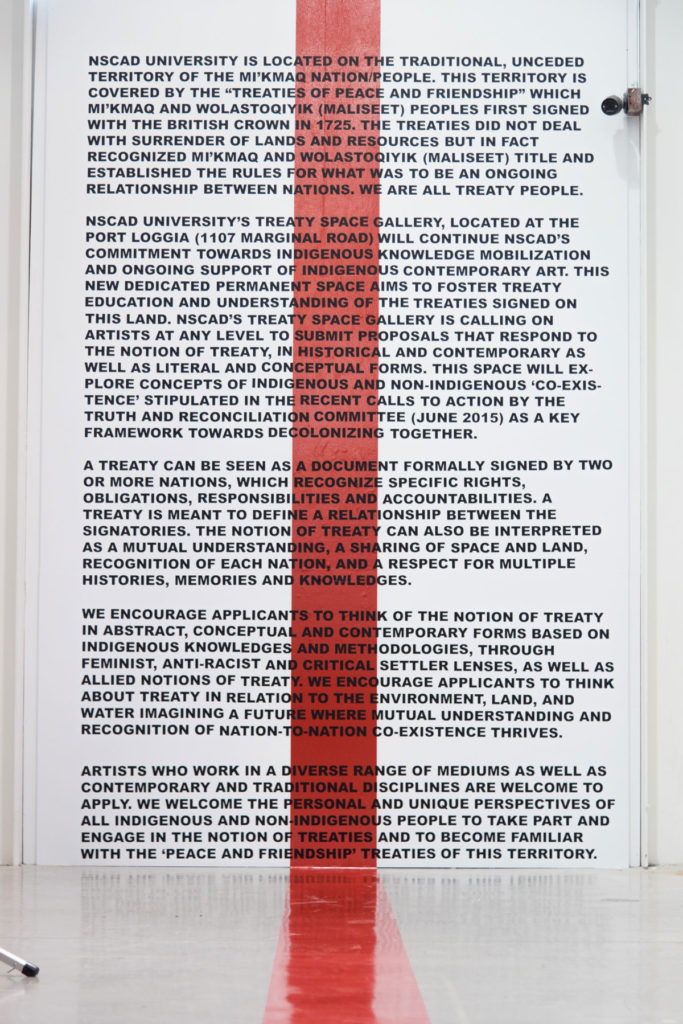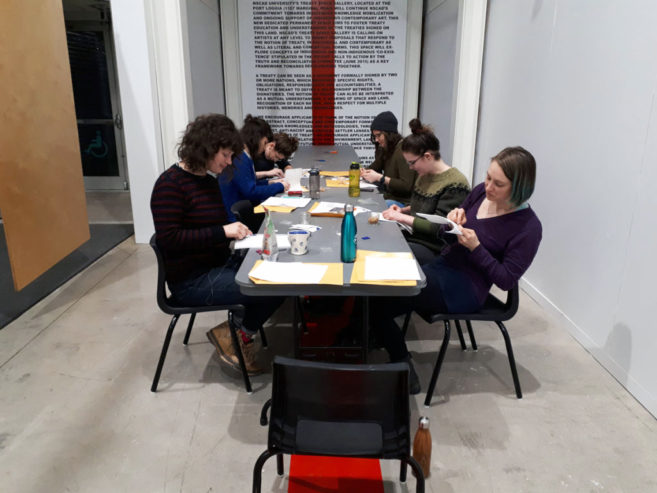What makes a gallery? Is it simply a place to showcase various forms of art, or can it be more? Can a gallery be a library, a decolonizing tool, a place for learning?
In three different organizations across the city of Halifax, artists can be seen changing the perception of what a gallery can be—pushing the space to do more.
In the back of Plan B, a Gottingen Street store offering everything from vintage clothing to taxidermied animals, sits a small event space which has been used as a venue for music, group meetings and in mid-November, an art exhibition.
Brad Jones’s “Trans is Art” took place in this venue for three days, exhibiting eight portraits captured by Jones, a photographer, of local trans and non-binary individuals.
Sitting in the centre of the photographs was the organizer’s statement, which reads in part, “The few transgender people that we now see portrayed in the mainstream society are primarily very rich, upper-class transgender people. The appearance of not-famous transgender characters are often … so that the punchline of the joke is the character’s transgender status. Transgender people are not a joke; we are real, we are valid, we are queer, we are here and we are fierce.”
On the far left side of the portraits, the show’s title was printed out with this subtitle underneath: “Raising awareness and claiming space for non cis-gender people. Our existence matters.”
 A view of the Plan B storefront on Gottingen Street. This non-profit social enterprise co-op also has an event space which has been used as a meeting space for groups and clubs, a music venue for small underground bands, a 30-seat theater, a live drawing class, dances, pot lucks and, yes, art exhibitions. Photo: Courtesy Plan B.
A view of the Plan B storefront on Gottingen Street. This non-profit social enterprise co-op also has an event space which has been used as a meeting space for groups and clubs, a music venue for small underground bands, a 30-seat theater, a live drawing class, dances, pot lucks and, yes, art exhibitions. Photo: Courtesy Plan B.
The “Trans is Art” show was small, its eight colour glossy portraits all sitting together side by side on a single blue wall—but it packed a punch. The photographs themselves are beautiful, each one distinctly personal. Many of the subjects look straight back out at you, meeting your gaze with their own. Jones’s photographs did just what the show claimed: they controlled the gallery space and asserted a passionate determination to make each individual’s identity seen and paid attention to.
Brad Jones’s “Trans is Art” changed the Plan B gallery space into something greater than an art venue during the run of their show; it crafted a space for educating about and bringing awareness to trans and non-binary experiences and individuals within the Halifax community.
Shaya Ishaq is an interdisciplinary designer, craftswoman, community organizer and DJ in Halifax, and as of November 27 is the Khyber Centre’s current artist-in-residence. Ishaq’s residency focuses around the project Black Libraries Matter: Collective Calls to Liberation, an attempt at envisioning liberation of the imagination through literature, solidarity and narratives of resilience woven through Black communities within Canada.
Ishaq’s artist statement for Black Libraries Matter asks, “What does it mean to assert that #BlackLivesMatter in Halifax? What does a Canadian Afrofuturistic utopia that does not uphold anti-Black violence look like?”
The statement continues: “In this space, we acknowledge the erasure of our stories as a tactic enforced by the settler-colonial project. This settler-colonial project works to separate us from each other while also attempting to tear down the work that actively challenges state violence.”
 Shaya Ishaq’s Black Libraries Matter project at the Khyber Centre for the Arts creates the space for a crowd-sourced library. Photo: Chelsea Rozansky.
Shaya Ishaq’s Black Libraries Matter project at the Khyber Centre for the Arts creates the space for a crowd-sourced library. Photo: Chelsea Rozansky.
Black Libraries Matter is, above all else, a community project, the residency itself creating a space for a crowd-sourced library. This library offers literature, music and film, with contributions coming from Black Halifax and Nova Scotian community leaders, thinkers, artists, activists and everyday folks. The North Memorial Public Library is also aiming to bring in around 100 books and listening materials.
What Ishaq is creating is a sense of place and a forum for discussion, turning the gallery into an interactive library hub to serve a community whose works and contributions are often disregarded within Halifax and throughout the rest of the country.
Shaya Ishaq’s Black Libraries Matter is centering voices we often seat on the back burner and continuing to ask the difficult questions in a safe space of her own design.
Over in NSCAD University’s Port Campus, the student-created Treaty Space Gallery covers the entirety of the southern wall of the Port Loggia. Officially opened on October 2, the Treaty Space Gallery’s conception was led by Indigenous students Carrie Allison Goodfellow, Brandon Hollohan, and Glenn Knockwood in response to the Truth and Reconciliation Commission’s recommendations.
With assistance from NSCAD associate professor Carla Taunton, Goodfellow, Hollohan and Knockwood researched “responses to treaty” and explored the ways treaty education spaces have been used on university campuses, developing the gallery concept with guidance from NSCAD’s Anna Leonowens Gallery.
The furthest wall of the gallery is painted white, with the space’s mission statement overlaid in black vinyl text from ceiling to floor. This text encourages the onlooker to consider the notion of “treaty in abstract, conceptual and contemporary forms” and goes on to acknowledge the unceded and un-surrendered Mi’kmaq land that NSCAD sits upon.
Through the middle of the Treaty Space Gallery wall text, a thick red band travels down the entirety of the wall then continues out across the floor, creating what feels like an all-encompassing band of wampum.
 A view of the Treaty Space Gallery at NSCAD University. Photo: Katherine Nakaska.
A view of the Treaty Space Gallery at NSCAD University. Photo: Katherine Nakaska.
NSCAD’s Treaty Space Gallery is not an art piece per se. The gallery attempts to function as a decolonizing tool for the university, continuing the school’s actions towards mobilizing Indigenous knowledge as well as supporting Indigenous artists and art. The gallery itself will also become a space to foster the coexistence of artistic and academic research alongside Indigenous community-based practices and knowledge.
The Treaty Space Gallery gives NSCAD and all those who enter the space an introduction to local and national Indigenous histories, and it allows for an activation of contemporary Indigenous lived experiences within the Mi’kmaq territory and further beyond. By presenting the viewer with an immediate source of information in the form of a wall text, the gallery also offers an opportunity for all Halifax communities to learn more about treaty histories and accountabilities. The hope is that this will advance a deeper understanding of treaties in the Nova Scotian and Canadian contexts, drawing upon the understanding that as non-Indigenous and Indigenous peoples alike living within Canada, “we are all treaty people.”
As stated in the official press release for the gallery, “Ultimately, this innovative space will explore concepts of Indigenous and non-Indigenous ‘co-existence’ stipulated in the recent Calls to Action by the Truth and Reconciliation Committee (June 2015) as a key framework towards decolonizing together.”
Emma Steen is currently finishing a degree in art history with a focus on Indigenous art histories and visual culture at NSCAD University. She is also currently taking part in a curatorial internship at the Art Gallery of Nova Scotia.

 A view of the Treaty Space Gallery at NSCAD University. A long red line is installed through the space. Photo: Katherine Nakaska.
A view of the Treaty Space Gallery at NSCAD University. A long red line is installed through the space. Photo: Katherine Nakaska.







